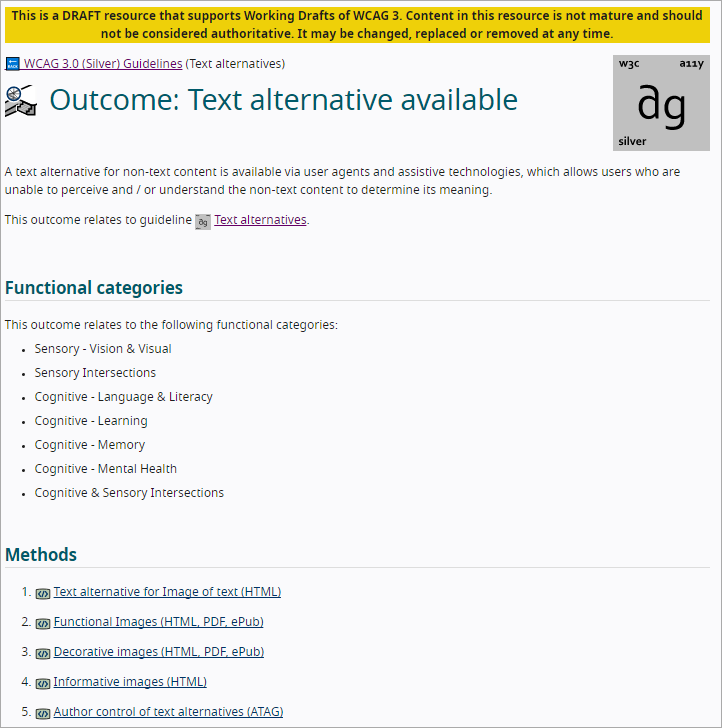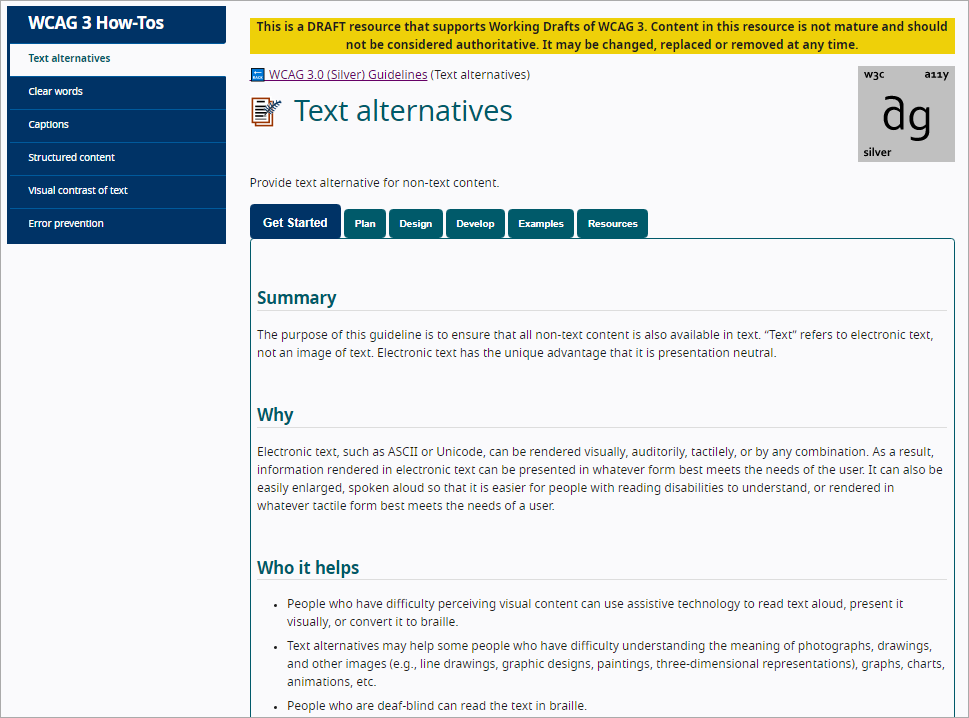In short: no.
Overview
On 7 December 2021, the W3C Accessible Guidelines Working Group published a Working Draft of the W3C Accessibility Guidelines (WCAG) 3.0.
So, that’s it, right? Pack WCAG 2 off to the junkyard? The standard is dead, long live the standard?
Well, no.
A Working Draft is published to invite feedback and goes through a lot of stages before it can be referred to as a standard. This particular draft has just six sample guidelines, where eventually there will be many, many more.
Given the amount of content yet to be added, the incorporation of feedback and revision, and giving people time to wrap their heads around some fundamental changes from WCAG 2 to WCAG 3, it’s going to be several years before WCAG 3.0 becomes a W3C Recommendation and web standard.
Remembering that WCAG 2.2 was originally slated for 2021 and by October 2022 had been pushed back to “early 2023”, WCAG 3.0 is unlikely to move out of draft status before 2025 at the very earliest, and quite probably a few years later than that.
So, let’s just clarify where we’re at now, with all of these different versions of WCAG.
Document Status
WCAG 1.0 became a W3C Recommendation on 5 May 1999, which means the W3C endorsed it and it could be quoted as a standard. Became a Superseded Recommendation on 18 May 2021, no longer recommended for implementation.
WCAG 2.0 became a W3C Recommendation on 11 December 2008, which means the W3C has endorsed it and it may be quoted as a standard.
WCAG 2.1 became a W3C Recommendation on 5 June 2018, endorsed by the W3C and may also be quoted as a standard.
WCAG 2.2 became a W3C Candidate Recommendation Snapshot on 6 September 2022, which means it has been reviewed by the W3C, but is intended to gather final feedback, and must not be quoted as a standard. One WCAG 2.2 Success Criterion is currently marked as “at risk” due to “concerns around implementation and testing challenges” and may be removed before the document moves past Candidate Recommendation status.
WCAG 3.0 became a W3C Working Draft on 7 December 2021. It is the first publication of the document, has not been reviewed and endorsed by the W3C and must not be quoted as a standard.
WCAG 3.0 is a successor to WCAG 2.2 and previous versions but “does not deprecate these versions”. This is the same approach taken with versions 2.2 and 2.1 over 2.0. WCAG 2.0 and 2.1 remain W3C Recommendations, while 2.2 is likely to become a Recommendation in 2023.
The difference with WCAG 3.0 is that it includes additional tests and different scoring mechanisms, so it isn’t considered backwards compatible with WCAG 2.x. It’s designed to be “an alternative set of guidelines”.
Even when (or if) 3.0 becomes a Recommendation, some organizations may prefer to continue using WCAG 2.x to remain consistent with their existing policies.
From here on, for the sake of simplicity and clarity, we’ll refer to WCAG 3 and WCAG 2, unless there’s a reason to be specific about the versions referred to.
Let’s have a whip through the changes from WCAG 2 to WCAG 3.
Name
While they’ve kept the WCAG acronym, the expanded name has changed from Web Content Accessibility Guidelines to W3C Accessibility Guidelines.
Focus
The focus of WCAG changes from “web content” to digital products including “including web, ePub, PDF, applications, mobile apps, and other emerging technologies”.
Where WCAG 2 was technology-agnostic, WCAG 3 can provide technology-specific advice on digital accessibility.
WCAG 3 will “incorporate content from and partially extend” the User Agent Accessibility Guidelines (UAAG 2.0) and the Authoring Tool Accessibility Guidelines (ATAG 2.0).
POUR Principles
In WCAG 3, the Principles are not referred to at all. That doesn’t mean that what they represent is no longer relevant, rather that the structure no longer needs to group Guidelines in that way.
Normative Requirements
In WCAG 2, the explanation of the difference between normative and non-normative was tucked away under Conformance in Section 5.
WCAG 3 provides this explanation in Section 2, so that users understand that Guidelines, Testing and Conformance provide normative content that affect conformance claims, while everything else including introductory material, diagrams, examples, and notes are non-normative, providing information but not affecting conformance requirements directly.

Guidelines
Section 3 of WCAG 3 contains the Guidelines, the requirements that must be met for conformance.
In WCAG 2, Guideline 1.1 Text Alternatives states, “Provide text alternatives for any non-text content so that it can be changed into other forms people need, such as large print, braille, speech, symbols or simpler language.”
In WCAG 3, Guideline 3.1 Text Alternatives states, “Provide text alternative for non-text content.”
In this case, the WCAG 3 Guideline is briefer, more concise and leaves the detail to the next level of guidance. Not all the WCAG 2 Guidelines will map so neatly to a WCAG 3 Guideline. The process for this mapping is in progress and can be followed at the WCAG to Silver Outline Map.
The aim is for WCAG 3 Guidelines to “be a list of guidelines with a unique short name, and the text of the requirement written in plain language”.
How Tos
In WCAG 2, each Guideline has a subsection of at least one Success Criterion, its conformance level (A, AA, or AAA), a link to an Understanding document, a link to a How to Meet document, a description, and any exceptions.
In WCAG 3, the Guideline has an accompanying link to a How To document, which is roughly equivalent to the WCAG 2 Understanding document, in that they both provide context needed to understand the concept of the Guideline, its impact and how the Guideline can be met.

Outcomes
In WCAG 3, the Guideline and How to link are followed by an Outcome, equivalent to WCAG 2’s Success Criterion. This is what’s tested to determine whether a requirement has been met.
Some of the detail from WCAG 2 Guidelines has been moved to WCAG 3 Outcomes and rephrased, followed by a link to a separate page with the Outcome description repeated. This is accompanied by a list of the Functional Categories related to the Outcome (i.e., what disability types are affected), and a list of links to Methods for achieving the Outcome.
Critical Errors
WCAG 3 Outcomes specify any Critical Errors that will prevent an Outcome being achieved. In WCAG 2, these sit under Conformance as SC 5.2.5 Non-interference. If a web page doesn’t meet the requirements for WCAG 2 success criteria 1.4.2, 2.1.2, 2.3.1, and 2.2.2 then it can’t conform.
In WCAG 3.0 this concept is placed under each relevant Outcome as a Critical Error.
Methods
The Methods linked to from the Outcomes are approximately what were called Techniques in the How to Meet document in WCAG 2: the ways in which Outcomes can be achieved, with descriptions, examples, how to test and how to score the results of testing.

Testing
Each Methods page provides specific tests to be conducted. Currently, Atomic Tests for automated and manual testing are provided and these are equivalent to the pass/fail tests, procedures and expected results given for techniques for WCAG 2 Success Criteria.
As well as Procedures and Expected Results, WCAG 3 specifies how testing results should be measured. For example, the measurement for images of text having text alternatives is the number of images of text that do have alternative text divided by the total number of images of text. This delivers a percentage that can be ranked from Poor to Excellent. The presence of a critical error always delivers a percentage of 0 and a ranking of Very Poor and makes content non-conformant.
Additional Holistic Tests, conducted by users and experts and including with assistive technology, are “still to be developed.”
Scoring
Atomic Tests for each Outcome are scored on a five-tier rating system that includes the presence or absence of critical errors. While scoring thresholds will vary for each Outcome, they can be broadly described as:
- Very Poor (a score of 0) – less than 50% of tests are passed, or there are critical errors
- Poor (1) – 50% to 79% of tests are passed, and there are no critical errors
- Fair (2) – 80% to 89% of tests are passed, and there are no critical errors
- Good (3) – 90% to 98% of tests are passed, and there are no critical errors
- Excellent (4) – 99% to 100% of tests are passed, and there are no critical errors
Scores by Outcome are averaged to get an Overall Score by Atomic Testing. To reach a basic level of conformance, an Overall Score of 3.5 is required, with no critical errors.
Consideration of how well users’ Functional Needs related to an Outcome are met will deliver a “Score by Functional Category” that contributes to the overall level of Conformance. This is also still in development.
Conformance
WCAG 2 conformance Levels A, AA, and AAA have been replaced with Bronze, Silver, and Gold status, but that’s not an exact replacement. Bronze is the basic level of conformance and equates roughly to WCAG 2.1 Level AA, the conformance level generally accepted as the current required standard. Based on Atomic Testing, this requires an Overall Score of 3.5 in a range of 0 to 4, with no critical errors.
A web page that passed 96% of applicable tests and had no critical errors could claim WCAG 3.0 conformance to Bronze level.
Silver and Gold conformance status are achieved as the result of Holistic Testing, in addition to Atomic Testing. Bronze conformance is required to get to Silver and then Gold. The difference between Silver and Gold has not yet been documented.
User Generated Content
WCAG 3 requires conformance for user generated content, including social media posts and comments, and photos and videos uploaded by users.
Conclusion
Apart from naming conventions and document structure, the main differences between WCAG 2 and WCAG 3 are:
- Changing the focus from web content to all digital products
- Putting greater emphasis on critical errors in relation to each guideline
- Ranking test results on a percentage scale rather than pass / fail
- Including usability testing with users and assistive technologies
- Making methods, testing, and scoring technology-specific where appropriate
- Including user agent and authoring tool conformance
- Factoring in the specific functional needs of people with disabilities
- Requiring user generated content to be conformant
Clearly, there’s a long way to go before WCAG 3.0 becomes a Recommendation and can be used as a standard.
Now is the time to do two things.
Conform to WCAG 2.1 Level AA. As well as addressing most significant digital accessibility issues, and being able to claim conformance, you’ll be at Bronze level conformance when WCAG 3.0 eventually comes into effect. Get ready to implement the changes in WCAG 2.2 and you’ll be ahead of the game.
Review, test and feed back on WCAG 3.0. The sample Guidelines have been set up with enough detail to apply them to your web properties and digital products. Try them out, see what results you get and let the W3C know whether that’s a workable system.
WCAG 3.0 Resources
Originally published: https://tpgi.com/wcag-3-0-are-we-there-yet